Orvieto Cathedral has to be seen to be believed. Famous for its lacy and luminous exterior, fabulous frescoes and a blood-soaked altar cloth, this is one of the most spectacular cathedrals in Italy.
To make the most of visiting Orvieto Cathedral, here are ten essential Duomo di Orvieto facts that you should know before you go.

I’VE WRITTEN THIS ITALY SOLO TRAVEL GUIDE!
A 100+ page ebook to inspire and equip solo travellers with the confidence and knowledge to explore Italy independently
- Plan Your Trip – with curated itineraries, budgeting and how to get around
- Explore Awesome Destinations – guides to the must-see cities of Rome, Florence, Venice and Naples
- Stay Safe as a Solo Traveller – practical safety advice, empowering you to confidently navigate Italy and avoid common pitfalls
- Enjoy Eating Out in Italy – essential tried-and-tested solo dining tips
1. Orvieto Cathedral owes its existence to the Miracle of Bolsena
In 1263, a Bohemian priest, Peter of Prague, was making a pilgrimage to Rome. On his way, he was asked to celebrate Mass at Bolsena, a town 12 miles southwest of Orvieto.
Father Pater had been doubtful about the Catholic dogma of the transubstantiation of the Host and Wine into the Body and Blood of Christ. But as he started to say Mass, blood started to seep from the consecrated Host onto the altar cloth.
His faith restored, Peter travelled to Orvieto to present the linen to Pope Urban IV. The Holy Father proclaimed it a miracle and the cathedral was built to house this sacred relic.
This bloody cloth is housed in the Chapel of the Corporal, which you enter through a separate door.
On the left wall of the chapel, there are frescoes by Ugolino di Prete Ilario depicting the history of the Eucharist. Its right wall has those depicting bleeding Host miracles. These were painted between 1357 and 1363.
As this is reserved for private prayer only, it felt disrespectful to take photographs.
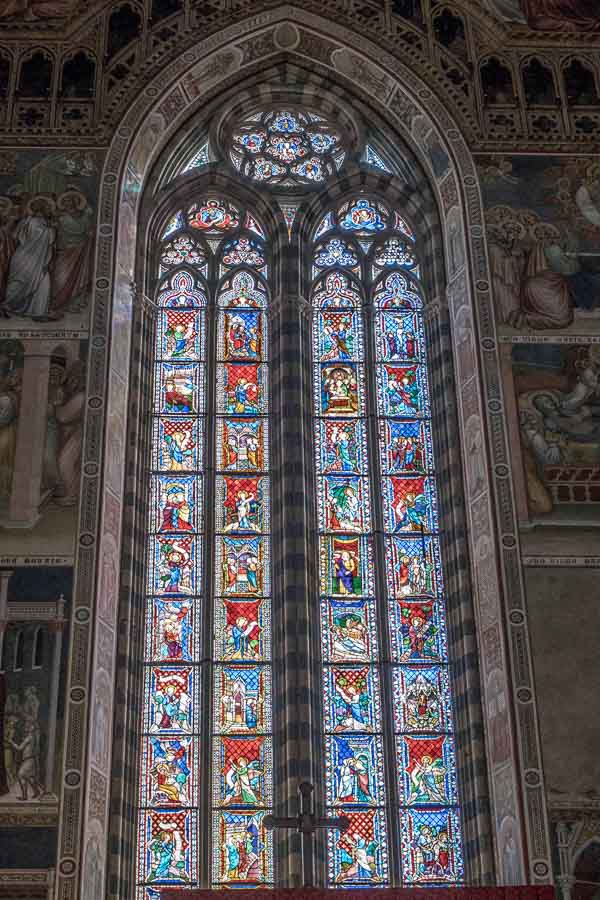
2. It took 300 years to complete
Like many European cathedrals, Orvieto Cathedral’s history is a long one.
The cornerstone of the Duomo was laid in 1290 by Pope Nicholas IV and work on it began in the Romanesque style.
The first architect is widely held to be Arnolfo di Cambio, the architect responsible for the Cathedral of Santa Maria del Fiore, one of Florence’s most famous landmarks. It was transformed into an Italian Gothic cathedral 20 years later by the master architect Lorenzo Maitani of Siena.
But that is not the end of its construction story.
Subsequent master architects tinkered with it, including Andrea Pisano, Andrea di Cione (known as Orcagna) and Michele Sanmicheli. It wasn’t until 1617 that its façade was completed.
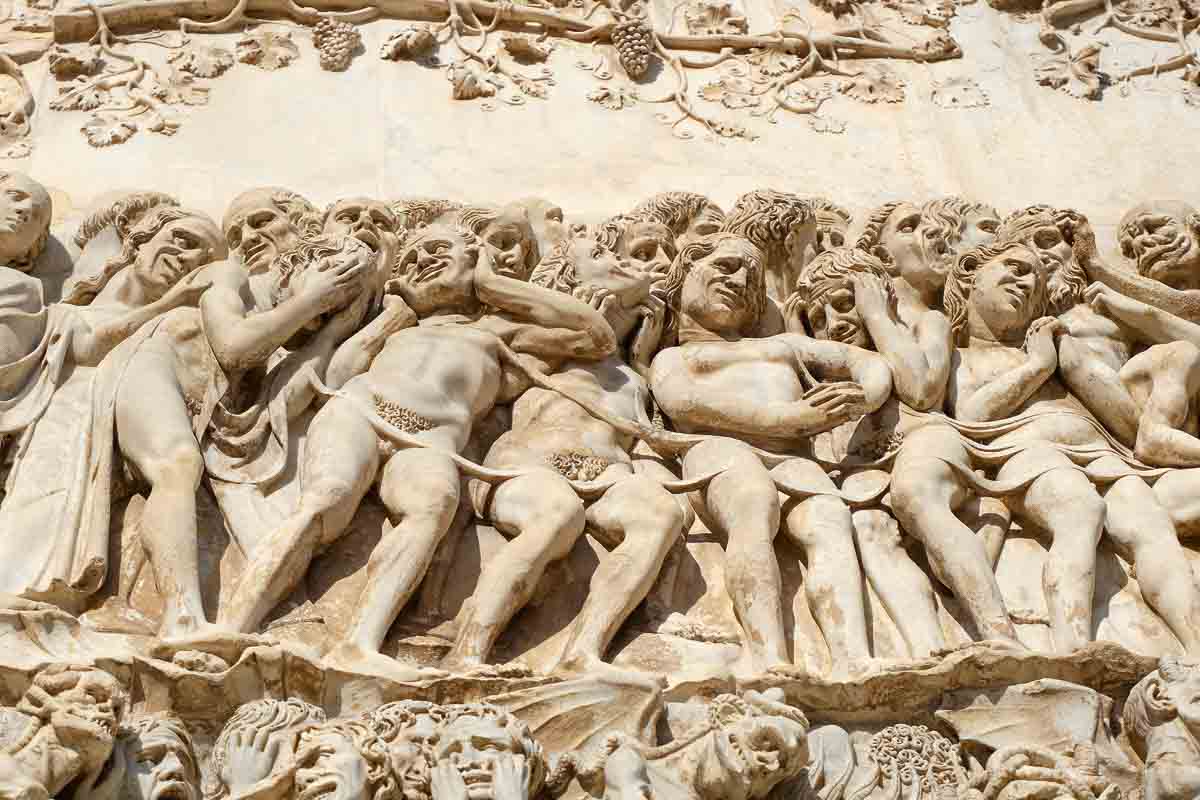
Local materials were used to build Orvieto Cathedral.
Its foundations and main skeleton are made from local tufa rock. Its side walls feature alternating rows of local white travertine and blue-grey basalt. Finally, red marble from Sosselvole and white marble from Carrara are used for its glorious façade.
3. Orvieto Cathedral is known as the ‘Golden Lily of Cathedrals’
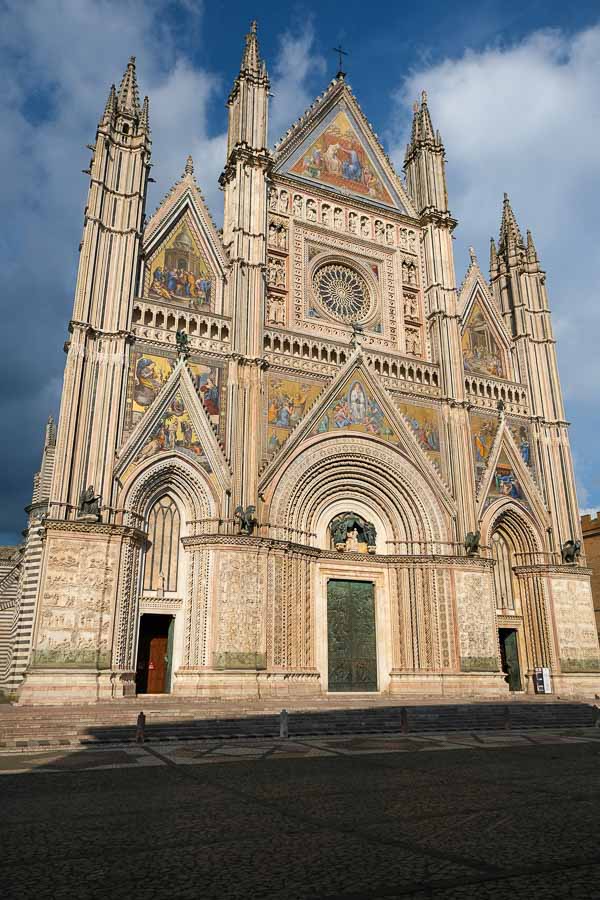
Orvieto Duomo’s sumptuous Gothic façade, resembling a giant medieval altarpiece, is the masterpiece of Lorenzo Maitani. Its mighty edifice is decorated with Technicolor mosaics and embellished with elaborate spires and lacy tracery.
It is a thing of wonder.
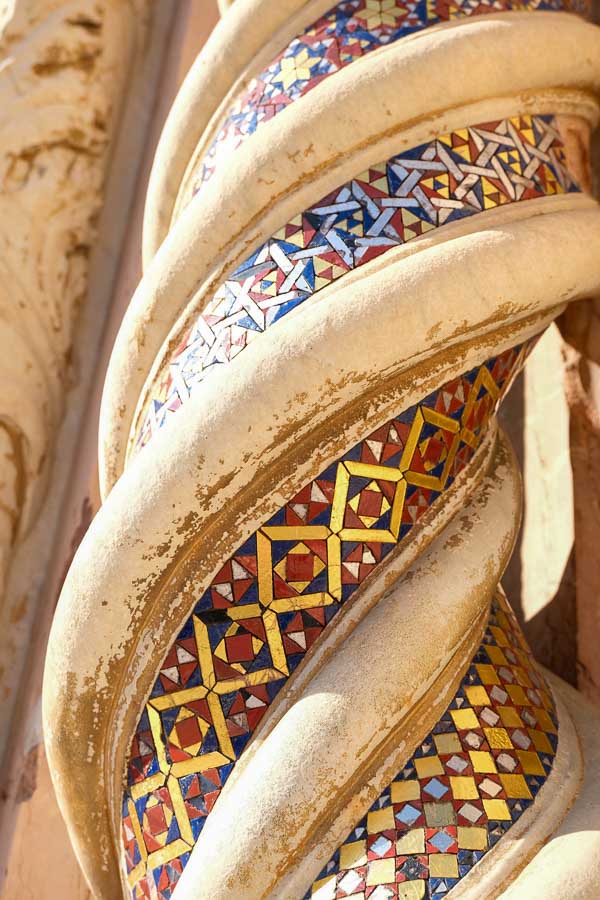
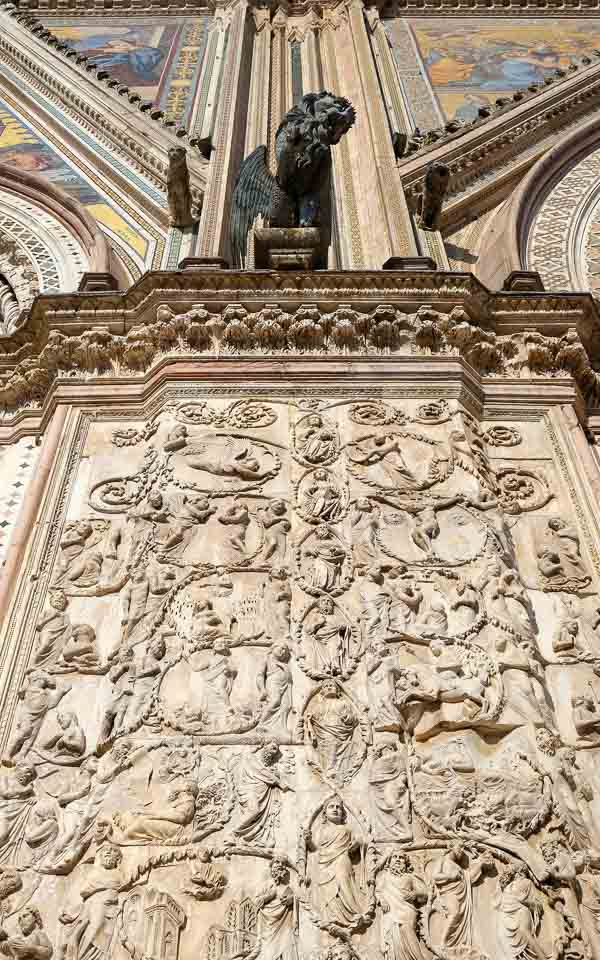
The carved pillars at the base of the façade are a Bible in stone, depicting Creation, the Tree of Jesse (Jesus’s family tree), New Testament scenes and the Last Judgement. Each of these pillars is crowned by a bronze symbol of one of the Evangelists.
Amongst all of this Gothic splendour, there are modern Bronze doors.
These are the work of the Sicilian sculptor Emilio Greco. You can see more of his sculptures in the gallery to the immediate right of the cathedral.
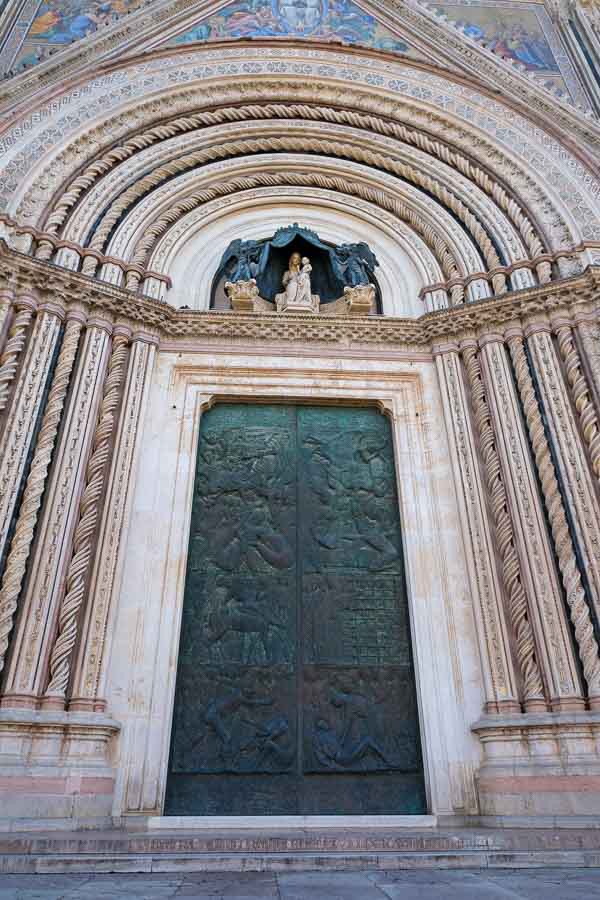
4. Orvieto Cathedral’s interior is a clever optical illusion
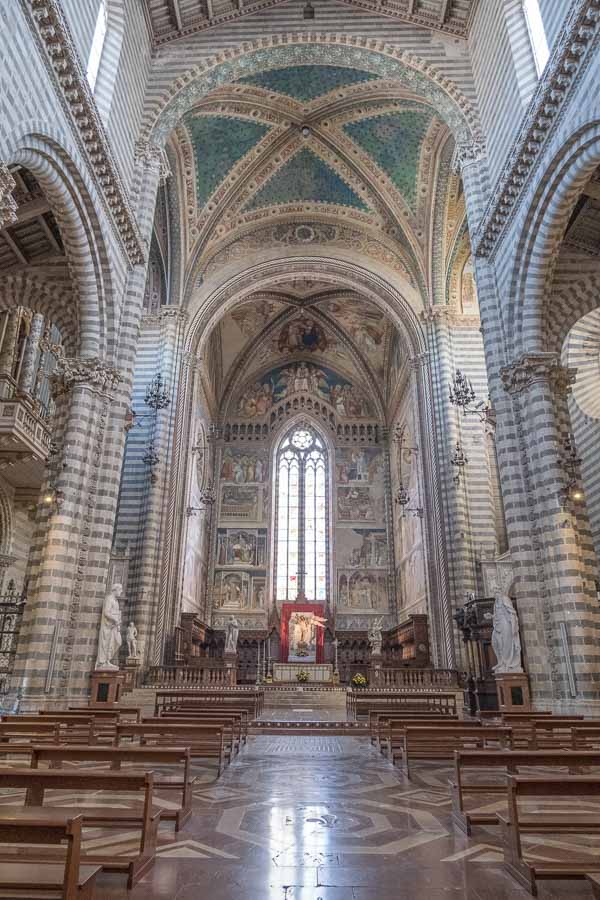
In contrast to the majesty of its exterior, the interior of Orvieto Cathedral is bland and austere, dimly lit with light filtered through alabaster windows.
Although it appears enormous, this is a clever optical illusion. Its zebra-striped columns and arcaded side chapels make the space seem longer and bigger than it is.
5. The nave is lined with magnificent statues
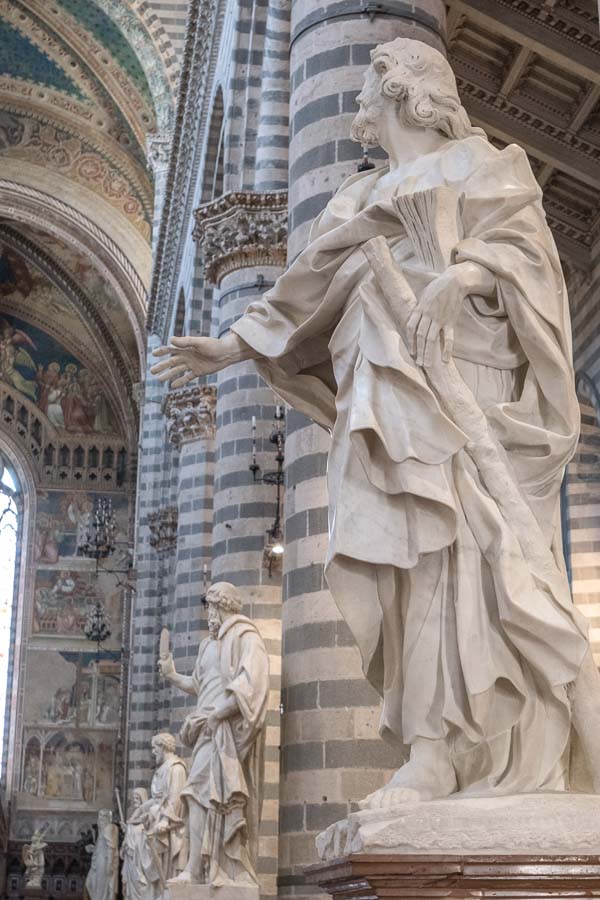
Lining the nave are 18 statues of the apostles, the Annunciation and the patron saints. These were only restored to the cathedral in 2019, following their removal during a restoration in 1897.
6. Its greatest treasure is the Capella della Madonna di San Brizio (Capella Nova)
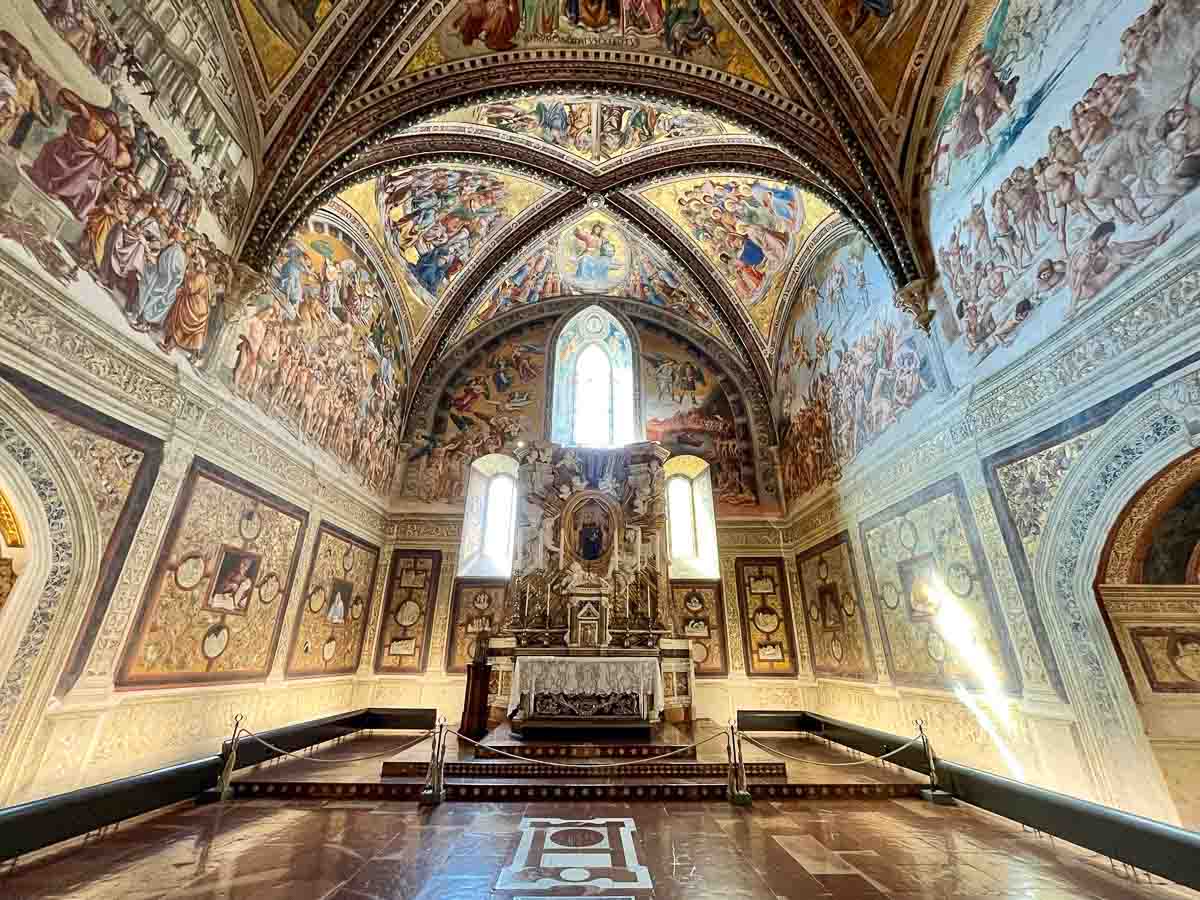
The Capella della Madonna di San Brizio is decorated with one of the finest fresco cycles of the Italian Renaissance and is one of the main reasons to visit Orvieto.
They were begun in 1447 by Fra Angelico, assisted by Benozzo Gozzoli. He had barely begun – he just managed to finish the serene Christ in Judgement – before he was summoned to Rome.
Perugino was then hired to take up the mantle but didn’t deliver. Finally, in 1499, the city commissioned Luca Signorelli (1450 – 1523) who completed the work according to Fra Angelico’s design.
It is Signorelli’s masterpiece.
In the Resurrection of the Bodies on the right wall, angels blow their trumpets as the dead emerge from the earth.
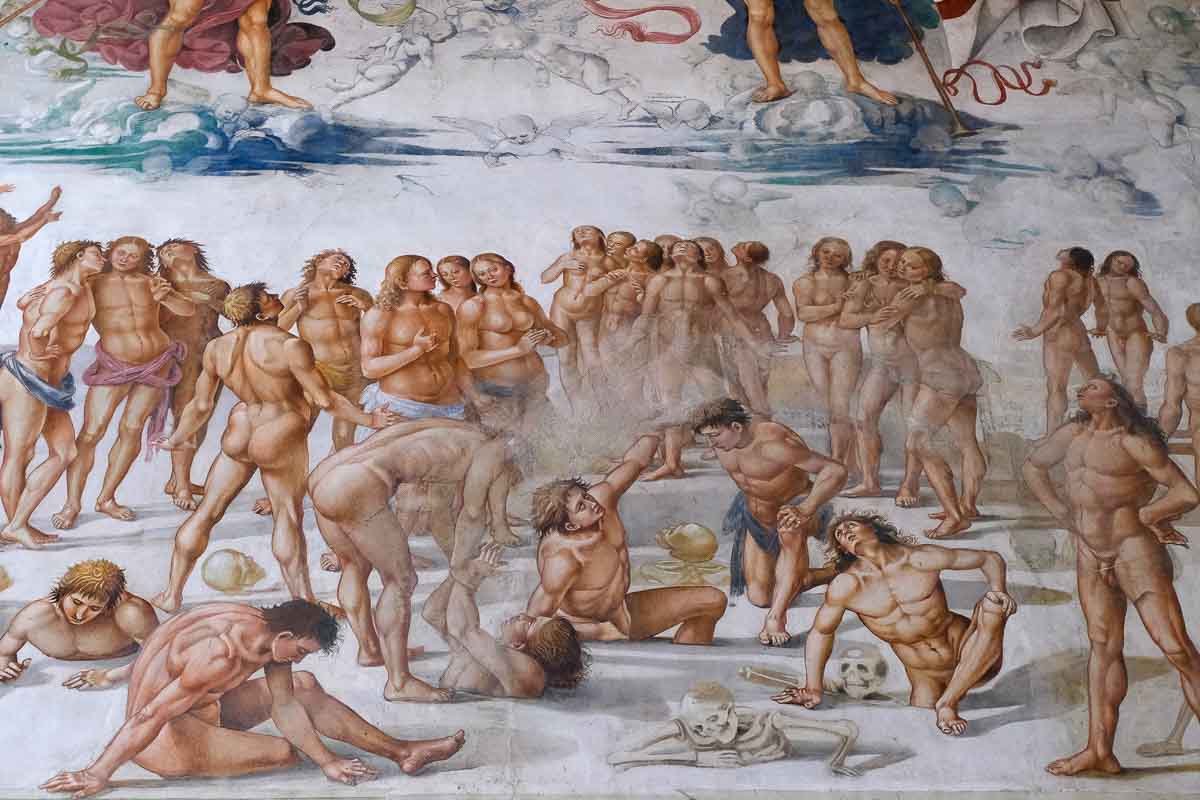
Below this is a moving Pietà, the emotion on the faces of the two Marys plain to see.
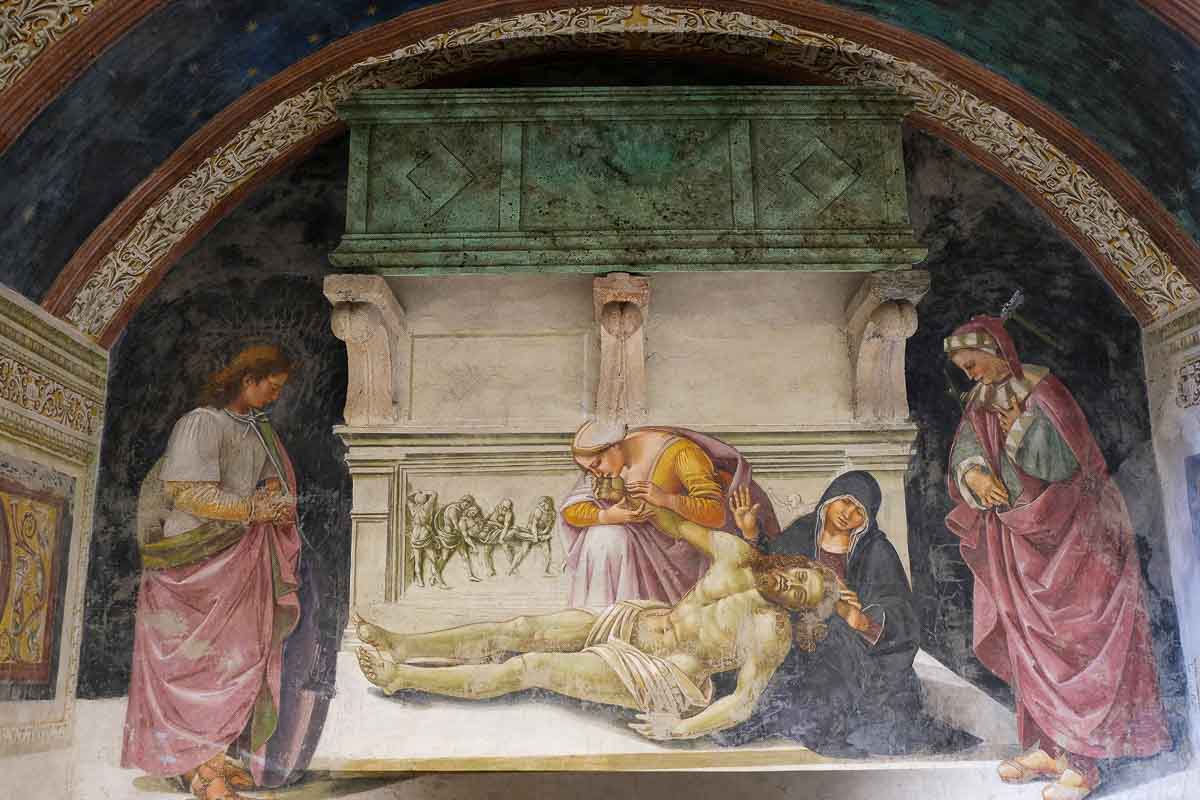
Take a look at the Sermon of the Antichrist on the opposite wall. The Antichrist, posing as Jesus, forgets his lines mid-speech but the Devil is on hand to tell him what to say next.
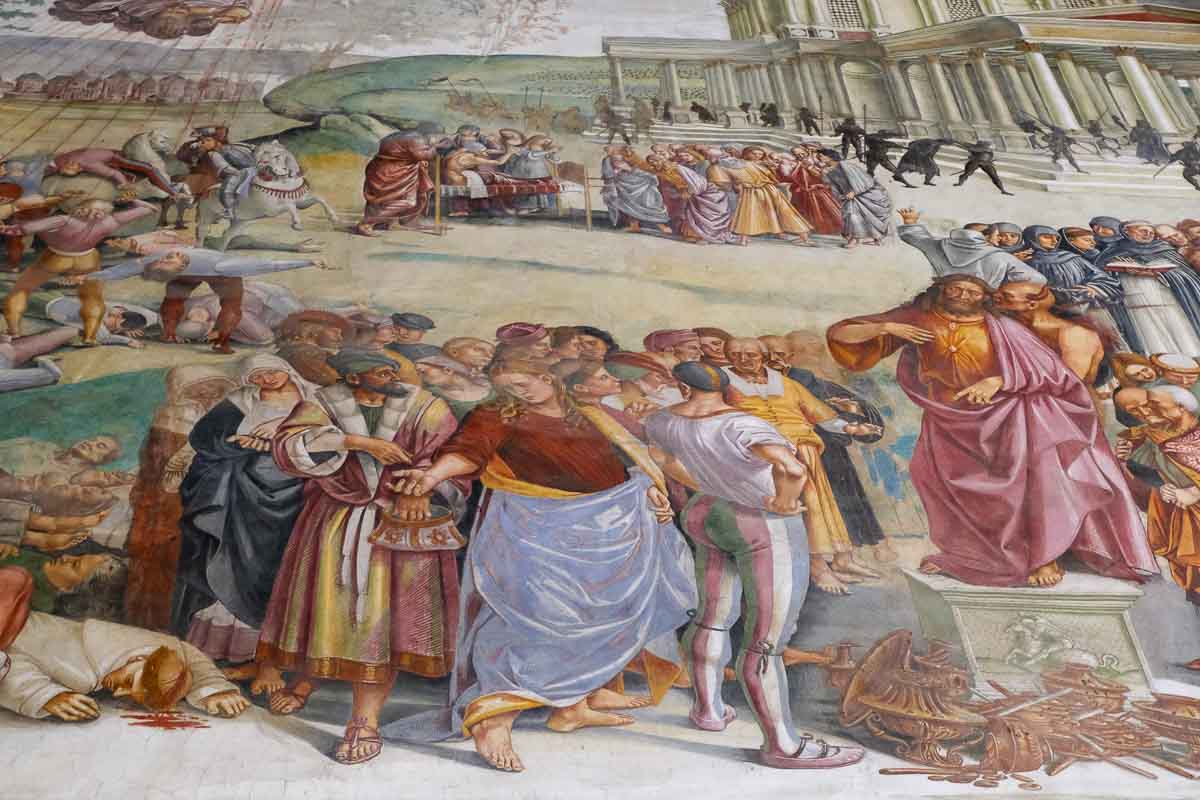
Over the window, the devils launch themselves on a terrified group of the dammed.
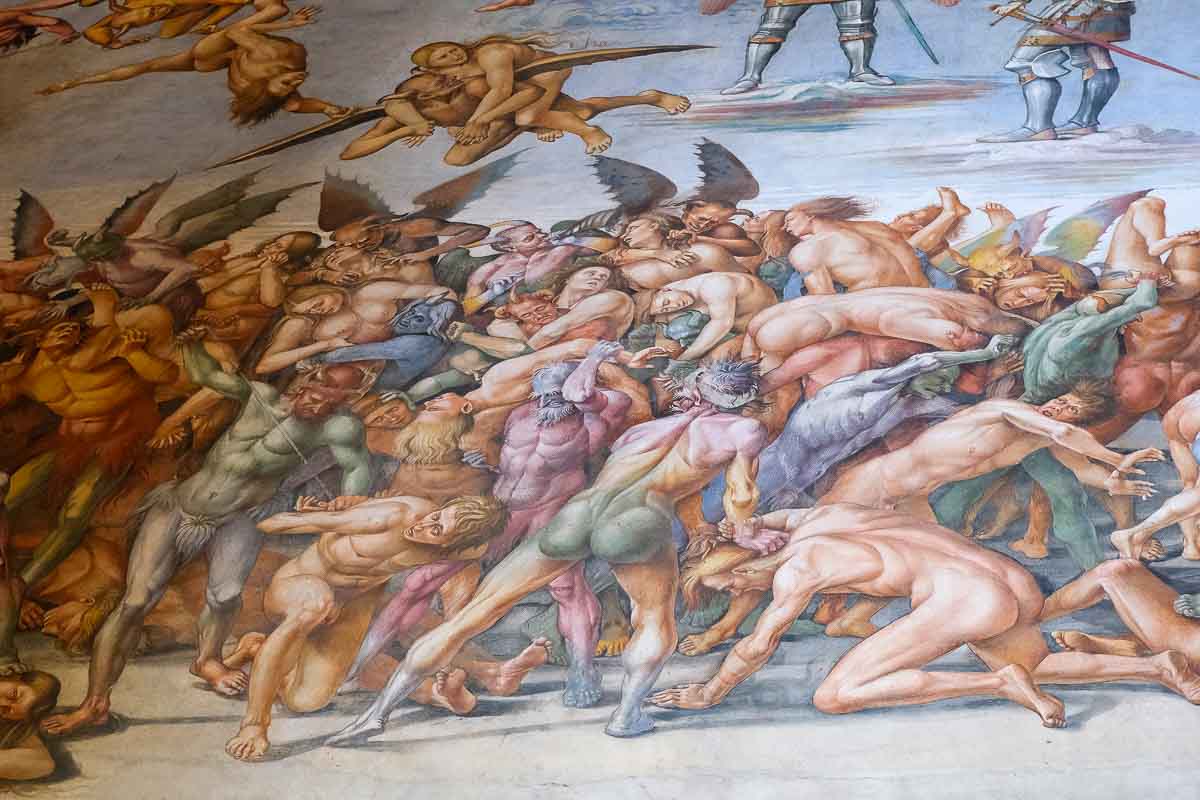
Don’t miss the self-portrait of the artist, dressed in black with long golden hair. He stands next to Fra Angelico, also in black.
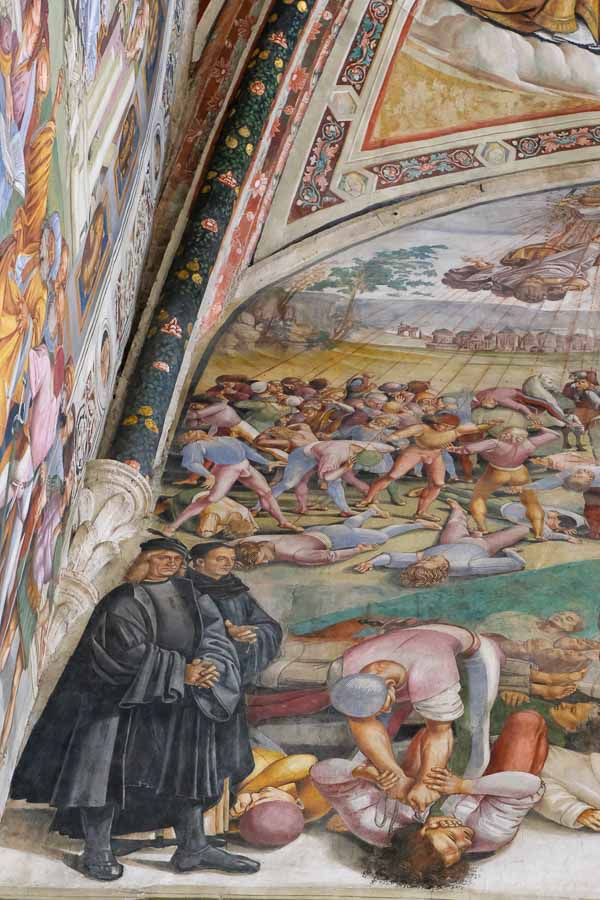
7. There is a visible reminder of the Counter-Reformation
During the Counter-Reformation, the altar was moved back so that the congregation could sit closer to the cathedral’s stained glass and frescoes. These had been designed to wow the commoners as a visual representation of the glory of Heaven, powerful propaganda for the Catholic church at that difficult time.
A patch on the marble floor marks the spot where the altar originally stood.
8. The Cathedral of Orvieto has a fine Pietà statue
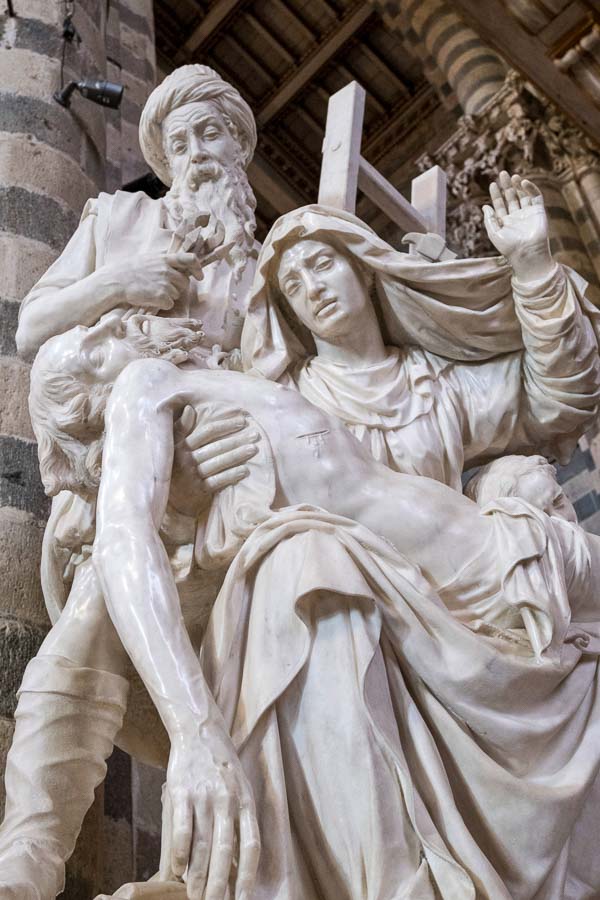
Inspired by that carved by Michelangelo, local artist Ippolito Scalza sculpted this exquisite Pietà in 1579.
Made from one piece of marble, it shows Mary cradling Jesus’s dead body. Just look at the rich drapery and the unity of this group of figures.
9. You can see the exquisite Madonna and Child Enthroned with Angels
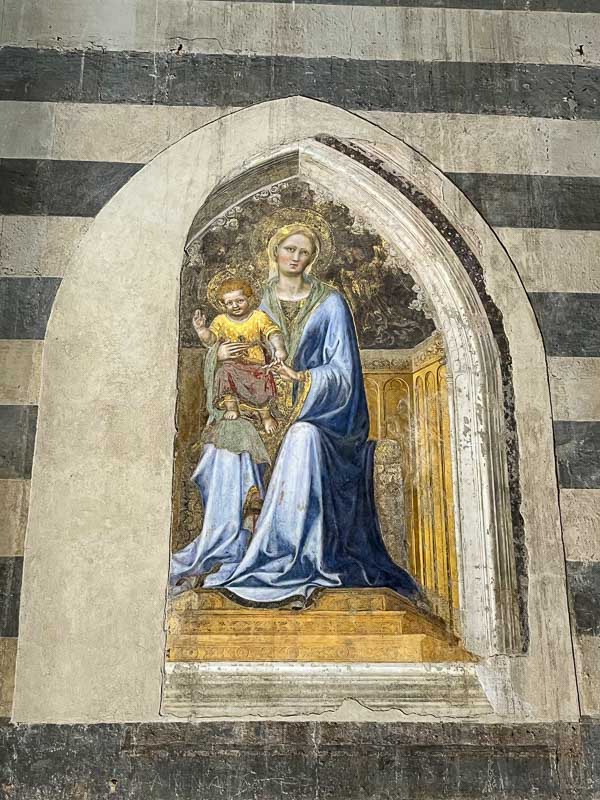
Just before the cathedral’s exit, there is a small fresco. This is the wonderful Madonna and Child Enthroned with Angels (1425) by Gentile de Fabriano.
10. Duomo di Orvieto is home to a magnificent 15th Century organ
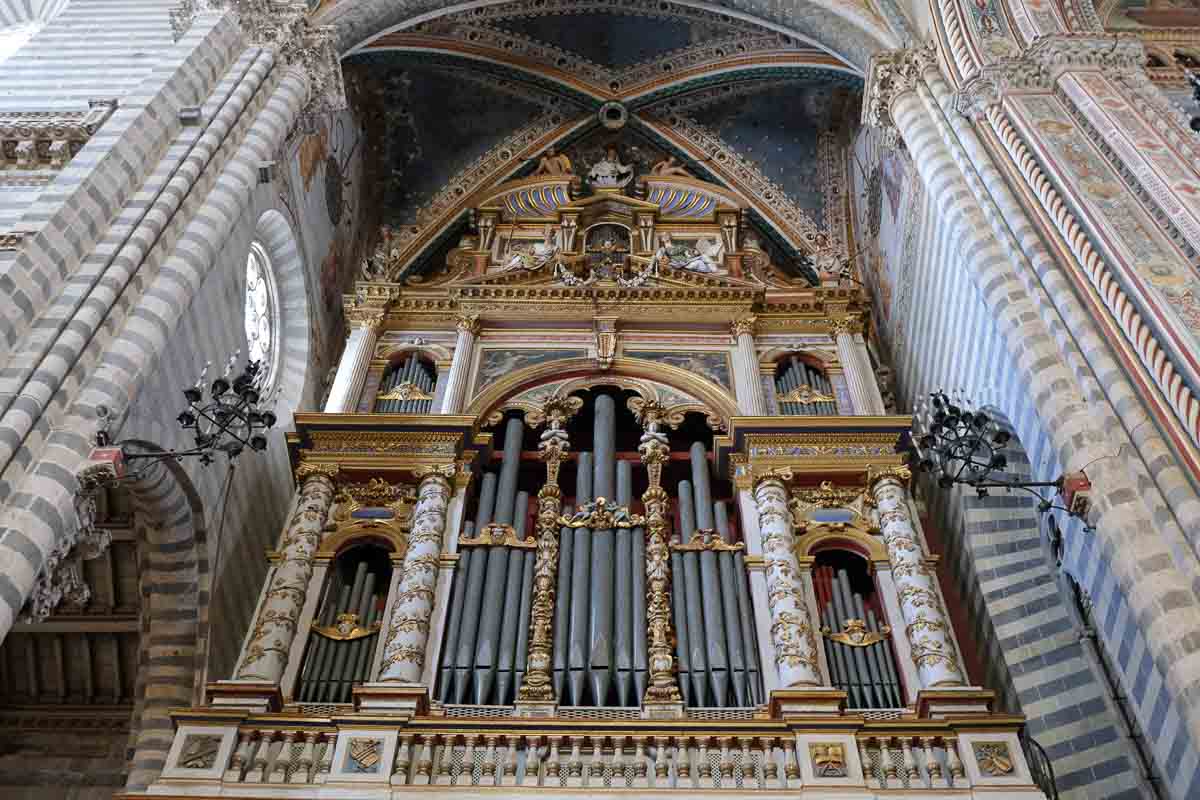
What’s a cathedral without an organ?
Above the entrance of the Chapel of the Corporal is the cathedral’s organ. Originally designed by Ippolito Scalza and Bernardino Benvenuti in the 15th Century, it is said to contain 5,585 pipes.
But who’s counting?
Visiting Orvieto Cathedral: Practical information
Address: Piazza del Duomo, 26, 05018 Orvieto
Opening hours: Check the seasonal opening hours on the cathedral’s website
Admission fee applies. Included with the Orvieto City Card (Orvieto Carta Unica).
In 2024, this Orvieto City Card costs €25. In addition to Orvieto Cathedral, it gives you free admission to these eight sites:
- MoDo Museum
- National Archaeological Museum
- Faina Etruscan Museum
- Necropolis of the Crocifisso del Tufo
- Orvieto Underground
- Well of the Cava
- St. Patrick’s Well Torre del Moro
Is the Orvieto City Pass worth it? Like any city pass, you will need to do the maths, based on what you plan to visit in Orvieto. But maxing out this card saved me €14 in admission fees.
Orvieto Cathedral is 100% worth visiting
Inside and out, Orvieto Cathedral is a feast for the eyes and should be number one on your list of things to see in Orvieto.
Try to visit the cathedral twice.
Beat the tour groups and get there as it opens its doors. You’ll have the place pretty much to yourself.
Later in the day, do as I did. Admire it over a glass of Orvieto Classico in Piazza del Duomo at the end of the day, when the mosaics glow with life.
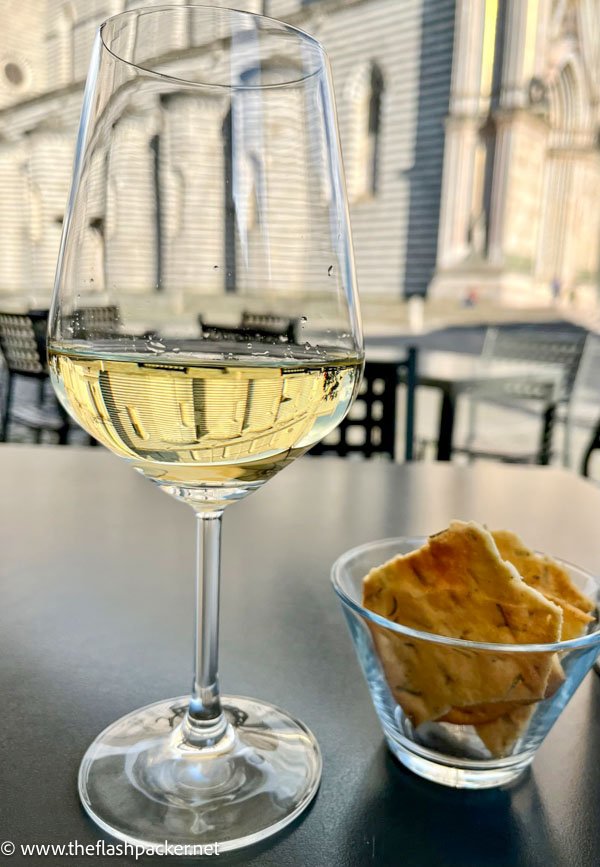
READ THIS NEXT: 20 Magical Things to Do in Orvieto, Italy

About Bridget
Bridget Coleman has been a passionate traveller for more than 30 years. She has visited 70+ countries, most as a solo traveller.
Articles on this site reflect her first-hand experiences.
To get in touch, email her at hello@theflashpacker.net or follow her on social media.

